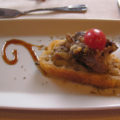David Pogue of the New York Times has written a series of articles on “Customer Service Cluelessness,” in which he postulates that the incorrect billing many of us suffer from various companies is actually a money-making stratagem: most of us won’t notice small discrepancies on our bills, or won’t spend the time to communicate with the companies to get them fixed, so the companies get to keep the bulk of their ill-gotten gains.
As I mentioned before, Tiscali, my former ADSL provider, tried to stick me for € 570 back in July, after I had left their service. But that was only the end (I hope) in the Tiscali saga.
That began two years previously, when I was first trying to get ADSL up and running in Milan. I applied online in April, had some paperwork problems, and didn’t actually receive the modem until June. Then there were problems with the line, which would have to be fixed by Telecom Italia, and Tiscali told me that could take weeks – by which time I expected to be out of the country. I told them: “Call me as soon as it’s fixed;” the only other way for me to know it was working would have been to test it myself every day.
I didn’t hear anything. I returned to Milan on September 10th, 2001, and called tech support again the next day.
“Oh, that was fixed back on July 11th,” he said, “Why don’t you try it now?”
I tried to go to to CNN, but couldn’t get through. “Still not working,” I said.
“Try our site,” he said.
I did. It had a news feed. And that was how I found out about the Twin Towers. “Something very bad is happening,” I said, and hung up on him.
The good news was that the line was in fact working. However, when the bill arrived, they had billed me back to July, wanting me to pay for two months in which I had not been using it, because I didn’t know it was working.
I called customer service. “We got it working in July,” they said, “so we began billing in July.”
“I was home and could have used it til August,” I replied, “but you were supposed to TELL me it was working, and you didn’t.”
“The technician tried to call.”
“He must not have tried very hard. We have an answering machine. Or why didn’t he send email?” No satisfactory answer was forthcoming.
I decided to make a formal complaint. The customer service rep said I should write all the details in an email and send it to an anonymous customer service address.
“Fine,” I said. “I’ll copy it to your president. What’s his name?”
“That’s not necessary,” said the lady stiffly. And she refused to tell me the name. I was surfing the net while on the phone with her. A few clicks later, I found Tiscali’s corporate site.
“Ah, here he is: Renato Soru. Okay, let’s try renato.soru@tiscali.com…”
She went into a panic. “He’ll never read it!” she said.
I wrote a long message with all the details, being careful to give praise where that was due (“The customer service rep was very polite, even when I was screaming at her.”) and to explain what went wrong and where, and what kind of restitution I was expecting.
Renato Soru did read it, or at least his secretary did, and she replied politely that Dr. Soru thanked me for letting him know how things were going in customer service. She claimed that I would still have to pay for those two months, but in fact I was never billed for them, either through oversight or because someone realized that I shouldn’t be.
Writing to the big boss is an old trick in the US, but it seems that Italians are not used to it. It will still get results even in many US companies, if nothing else to get you off upper management’s back. Of course the email address of the president/CEO is not going to be posted on the website, but it’s usually pretty easy to guess: try variations on firstname.lastname@companyname.com, firstinitiallastname@, etc.; something is bound to work. webmaster@companyname.com may never answer you, but the president might.
Now we’re having a big hassle with Telecom about overbilling (to the tune of 500 euros). It’s time to write another letter…










